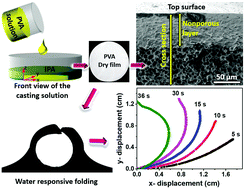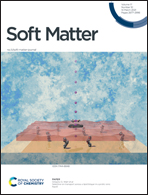Engineering polymer film porosity for solvent triggered actuation
Abstract
We report a novel approach for the fabrication of porous polymer films and their self-folding behavior in response to water. In this approach, the poly(vinyl alcohol) (PVA) films of tunable porosity are prepared by direct casting of aqueous PVA solution into a nonsolvent, isopropyl alcohol (IPA). The method developed is simple, efficient and low-cost. The results presented provide a modular route to tune the distribution of pores across the film thickness by varying the volume of nonsolvent and the polymer solution. We show that asymmetric porous polymer films (which consist of pores across a certain thickness of the film in the plane perpendicular to its surface) as well as symmetric porous polymer films (which have pores across the entire film) can be fabricated by this versatile method. The percentage of pores in the polymer film calculated as  , where tp is the thickness of the film across which the pores exist and ttotal is the total thickness of the film, can be tuned over a wide range. The emanated porous PVA films are found to show self-folding behaviour in response to water. Our results indicate that the pore architecture in the films significantly enhances the actuation speed. The self-folding originating due to the diffusion of water molecules across the film is observed to occur in a controlled and predictable manner for the films with 60% pores and above. A detailed study of the folding characteristics and actuation speed in relation to folding time is substantiated.
, where tp is the thickness of the film across which the pores exist and ttotal is the total thickness of the film, can be tuned over a wide range. The emanated porous PVA films are found to show self-folding behaviour in response to water. Our results indicate that the pore architecture in the films significantly enhances the actuation speed. The self-folding originating due to the diffusion of water molecules across the film is observed to occur in a controlled and predictable manner for the films with 60% pores and above. A detailed study of the folding characteristics and actuation speed in relation to folding time is substantiated.



 Please wait while we load your content...
Please wait while we load your content...